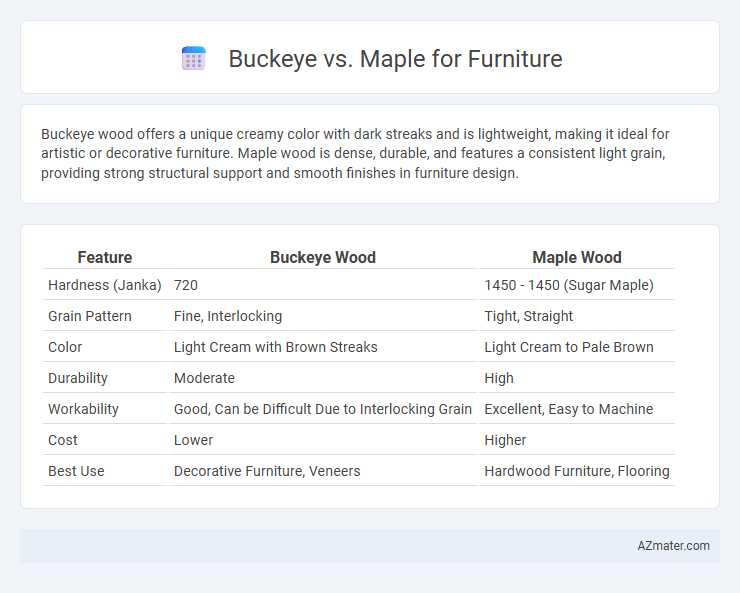Buckeye wood offers a unique creamy color with dark streaks and is lightweight, making it ideal for artistic or decorative furniture. Maple wood is dense, durable, and features a consistent light grain, providing strong structural support and smooth finishes in furniture design.
Table of Comparison
| Feature | Buckeye Wood | Maple Wood |
|---|---|---|
| Hardness (Janka) | 720 | 1450 - 1450 (Sugar Maple) |
| Grain Pattern | Fine, Interlocking | Tight, Straight |
| Color | Light Cream with Brown Streaks | Light Cream to Pale Brown |
| Durability | Moderate | High |
| Workability | Good, Can be Difficult Due to Interlocking Grain | Excellent, Easy to Machine |
| Cost | Lower | Higher |
| Best Use | Decorative Furniture, Veneers | Hardwood Furniture, Flooring |
Introduction to Buckeye and Maple Wood
Buckeye wood, known for its lightweight and soft texture, features a pale yellow to light brown color with subtle grain patterns, making it ideal for decorative furniture pieces requiring easy carving and finishing. Maple wood, prized for its durability and hardness, offers a fine, uniform grain with shades ranging from creamy white to light reddish-brown, often chosen for crafting sturdy furniture that withstands daily wear. Both woods provide distinct aesthetic and functional qualities, with Buckeye favored for intricate designs and Maple for strength and longevity in furniture production.
Appearance and Grain Patterns
Buckeye wood features a light, creamy color with occasional darker streaks, offering a soft and smooth surface ideal for refined furniture pieces. Maple displays a consistent pale cream to reddish-brown hue, characterized by fine, straight grain patterns that enhance durability and provide a classic aesthetic. Both woods showcase unique grain variations, with Buckeye's irregular swirls and Maple's uniform lines contributing distinct visual textures to furniture designs.
Durability and Strength Comparison
Buckeye wood exhibits moderate durability with a Janka hardness rating around 950, making it softer and less resistant to dents than maple, which has a higher Janka rating of approximately 1450. Maple, especially hard maple, is renowned for its superior strength and resistance to wear, ideal for high-traffic furniture pieces. Furniture made from maple typically lasts longer and withstands daily use better compared to buckeye, which is more suitable for decorative or less demanding applications.
Workability and Ease of Machining
Buckeye wood offers excellent workability due to its soft, lightweight texture, making it easy to cut, shape, and carve, ideal for detailed furniture pieces. Maple is denser and harder, requiring sharper tools and more effort during machining, but it provides a smooth finish and good resistance to wear. Both woods respond well to sanding and finishing, though Buckeye is preferred for intricate designs, while Maple suits durable, high-traffic furniture.
Cost and Availability
Buckeye wood is generally more affordable than maple, making it a budget-friendly option for furniture without sacrificing durability. Maple, widely available in North America, often commands a higher price due to its hardness and fine grain, which is preferred for high-end furniture pieces. Availability of buckeye can be more regional and limited, whereas maple's consistent supply supports large-scale production and varied design applications.
Finishing and Staining Potential
Buckeye wood has a smooth texture and light color that readily absorbs stains, allowing for versatile finishing options and a polished appearance in furniture. Maple features a dense grain with natural hardness, making it slightly more challenging to stain evenly but resulting in a durable, sleek finish when properly sealed. Both woods benefit from pre-staining conditioners to enhance stain absorption and achieve a uniform, attractive finish in high-quality furniture pieces.
Environmental Impact and Sustainability
Buckeye wood, sourced primarily from fast-growing Ohio buckeye trees, offers a lower environmental impact due to its rapid regeneration and minimal need for chemical treatments during processing. Maple, known for its durability and fine grain, often comes from sustainably managed forests with certifications like FSC, ensuring responsible harvesting and forest preservation. Both woods provide sustainable options for furniture, but Buckeye's quicker growth cycle generally results in a smaller carbon footprint compared to slower-growing Maple species.
Common Furniture Applications
Buckeye wood, known for its lightweight and smooth texture, is commonly used in crafting decorative furniture pieces, cabinetry, and turned items like bowls and chair legs due to its easy workability. Maple, prized for its hardness and fine grain, is extensively utilized in manufacturing durable furniture such as dressers, dining tables, and flooring, offering excellent resistance to wear and a polished finish. Both woods provide unique aesthetic qualities; however, maple's robustness makes it a preferred choice for high-traffic furniture, while buckeye suits intricate, low-stress designs.
Pros and Cons of Buckeye vs Maple
Buckeye wood offers a soft texture and unique grain patterns, making it ideal for decorative furniture, but it is less durable and more prone to dents compared to maple. Maple wood provides exceptional hardness, resistance to wear, and a consistent grain, suitable for heavy-use furniture, though it can be more expensive and harder to work with than buckeye. Choosing between buckeye and maple depends on prioritizing aesthetic appeal versus strength and longevity in furniture design.
Choosing the Right Wood for Your Furniture
Buckeye wood features a light, creamy color with subtle grain patterns, making it ideal for rustic or casual furniture designs. Maple offers superior hardness and durability, characterized by a smooth, consistent grain that suits both modern and traditional styles. Selecting the right wood depends on desired strength, appearance, and furniture usage, with maple favored for high-traffic pieces and buckeye chosen for decorative appeal.

Infographic: Buckeye vs Maple for Furniture
 azmater.com
azmater.com